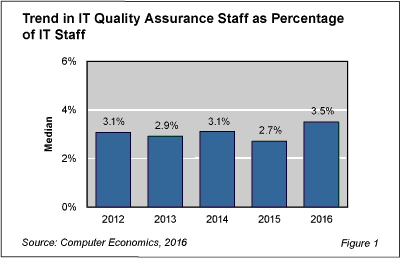In IT organizations, quality assurance (QA) is a well-established function that has changed little in size over the past five years or, for that matter, over the past two decades. Establishing QA is a small but vitally important requirement in every process-oriented environment.
Among all organizations that staff the position, the ratio of QA staff to IT staff is currently 3.5% at the median, a substantial increase from 2.7% the prior year, as shown in Figure 1 from our study, IT Quality Assurance Staffing Ratios. The increase may be partially due to an improving economy that allows organizations to pay attention to this key staff area. It may also be due to a decline in other areas, as the cloud allows organizations to shift some staff away from infrastructure. This staffing ratio has been otherwise fairly constant over the previous four years, ranging between 2.9% to 3.1%. A ratio of three QA staff members for every 100 IT staff members appears relatively constant throughout the period.

IT QA has been around since the beginning of IT, yet even today organizations often underestimate the vital role it plays. A capable IT quality assurance group will improve IT processes and ensure the effectiveness of projects, especially in application development and maintenance. Quality assurance staff can uncover inconsistencies early in the development cycle, reduce errors, and prevent rework, easily paying its way. But there also is a tendency in some organizations for the QA group to become overstaffed.
For benchmarking, IT organizations should not rely on the composite sample. In the full study, we provide three benchmarks to help IT managers determine the appropriate staffing level for this function. They include QA staff as a percentage of the IT staff, QA staff as a percentage of the Application Group, and applications per QA staff member. The benchmarks are provided by organization size and sector. We conclude with recommendations for improving the effectiveness of the quality assurance function within the IT organization.
The quality assurance mission is to provide managers with independently determined visibility into all processes, status, and quality of software development and upgrade projects, and to maintain the quality level of those products over their life cycle. Quality assurance personnel review, test, record, and audit software products to verify and validate their compliance with the standards and procedures the organization has established to ensure software and system quality.
Some software development experts note a technical difference between the roles of quality assurance and testing. Applying the former means outlining and implementing development standards, processes, and procedures before and during development to ensure quality. The latter is the act of searching for bugs after development. In practice, however, the distinction often becomes muddied. In this study, we define quality assurance staff as individuals whose job functions entail IT quality assurance, quality control, or testing. Other staff members who perform testing as a component of their job responsibilities (such as unit testing by application programmers) are not included in this category.
This Research Byte is a brief overview of our report on this subject, IT Quality Assurance Staffing Ratios. The full report is available at no charge for Computer Economics clients, or it may be purchased by non-clients directly from our website (click for pricing).
Do you also need staffing ratios for other IT job functions? Consider this collection of all of our staffing ratio reports, which bundles them all into a single report at a significant discount: IT Staffing Ratios–Special Report Bundle.

